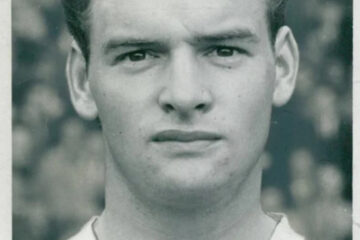The names of Marriott, Morris, and Pickering might not instantly come to mind when mentioning former members of Everton Football Club, but they played a major defensive role during their formative years on Stanley Park. The first of this trio to appear there was Thomas Marriott.
He was born 4 February 1861 and was the third son of Mary and her husband, John, who worked as a cotton porter. The family were, at that time, living at 2 Duke Street, but by 1881 they were living in better surroundings at Grey Rock Street where Thomas was working as a clerk. He first played at full back alongside Tom Evans, from whose experience all three were to benefit, during the season of 1880-81 after which he was partnered by a man from the North East of England.
Born in 1862, Richard William Morris was the son of John, a sergeant major with the South Durham Militia, and his wife, Harriet. They were then living at Scar Cottage, Barnard Castle in County Durham. Richard was residing at this address and working as a gardener, when the census was taken 3 April 1881. On the 13th of the same month he was recorded as attending the Everton AGM at the Queen’s Head Tavern in Liverpool.
Marriott and Morris first appeared together against Chester, in the opening game of the season on Stanley Park. The Everton were eliminated from the Lancashire FA knockout at Turton, but it is the game with Bootle which attracted the largest number of spectators. The next season saw the formation of the Liverpool & District FA, while Richard Morris was promoted to the role of Everton captain. On 11 November 1882, the Everton team travelled to Wrexham where John Pickering made his debut.
The fourth child of Yorkshire-born parents Richard and Louisa, he first saw the light of day 21 October 1865, when the family lived on Netherfield Road in Everton. The 1881 census shows that they settled on Roxburgh Street in Walton and that John was serving an apprenticeship to become a plumber. He first played for the Everton 2nd XI before taking part in the game at Wrexham, where the visitors lost 5-3.
Elsewhere on Merseyside, Bootle were now – thanks to the introduction of guest players – the strongest team in the area, as they beat Everton at home and on Stanley Park before eliminating them – on the enclosed ground belonging to Liverpool College, in the inaugural Liverpool FA knockout. Nevertheless, the game played on Stanley Park had been overwhelmed by the size of the crowd so Everton began next season on an enclosed ground on Lower Arkles Lane. (See ‘In Search of Priory Road‘ by Mike Royden).
Merriott, Morris and Pickering were to form the backbone of the Everton defence during the one season they played at this location which saw them reach the final of the local knockout. All three players took part in the game with Earlestown, at Bootle, which saw Everton win their first piece of silverware with a 1-0 victory. Next season they moved to a new enclosure on Walton Breck Road (Anfield).
John Pickering was the only player to take part in the inaugural game, which saw Everton beat Earlestown 5-0, but the trio were soon together as the season progressed. The Stanley Park Three again took part in the final of the Liverpool knockout, played at Bootle, where Everton surrendered the trophy to Earlestown, losing 1-0. Nevertheless, the quality of the fixture list had now improved which led to the club executive engaging the professional services of Welsh International players Job Wilding and George Farmer. They also offered the same terms to George Dobson.
The former Bolton Wanderers man was immediately made club captain and took the place of Richard Morris at full back. Tom Marriott accompanied him throughout the season and both players were present when Everton retained the Liverpool Cup with a 1-0 victory over Bootle.
John Pickering – who had made occasional appearances throughout the season – left the club to join Oakfield Rovers and was in the side that lost to Everton in the 1887 Liverpool Cup Final. Following their retirement from the game, the three former Stanley Park players spent the rest of their days living in Liverpool.

Richard Morris was still working as a gardener when, 27 December 1885, he married Hannah Mason at Holy Trinity church in Wavertree and both parties listed this area as their place of residence. At the time of the 1901 census the family, who had five children, were living at 12 Rose Lane in Mossley Hill, where the head of household was working as a coachman. He later moved to 28 Rose Lane where he became a goods trader, as he was employing the younger members of his family when he died in April 1936.
According to the 1891 census, John Pickering was still living in Walton when he married Hannah Harper at the parish church of St Mary on 18 September 1892. The couple then set up home at nearby Chepstow Street, where they raised a family. John Pickering had become a successful coal dealer at the time of his death in January 1928.
John Marriott – who always kept his amateur status – was leading the Everton appearances index when he played his last senior game, against Burnley, in April 1887. His regular place had by then been taken by Sandy Dick, a professional player who originated from Kilmarnock. Marriott was living at 24 Tyne Street when he married Jeanie Hughes, 16 July 1889, at Holy Trinity church on Breck Road. The 1901 census found the family, including two children, living at Handfield Road in Waterloo where they employed a domestic servant. Thomas Marriott had obtained the rank of office manager at the time of his death in July 1909.
..




